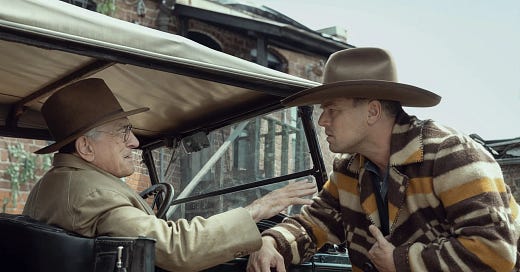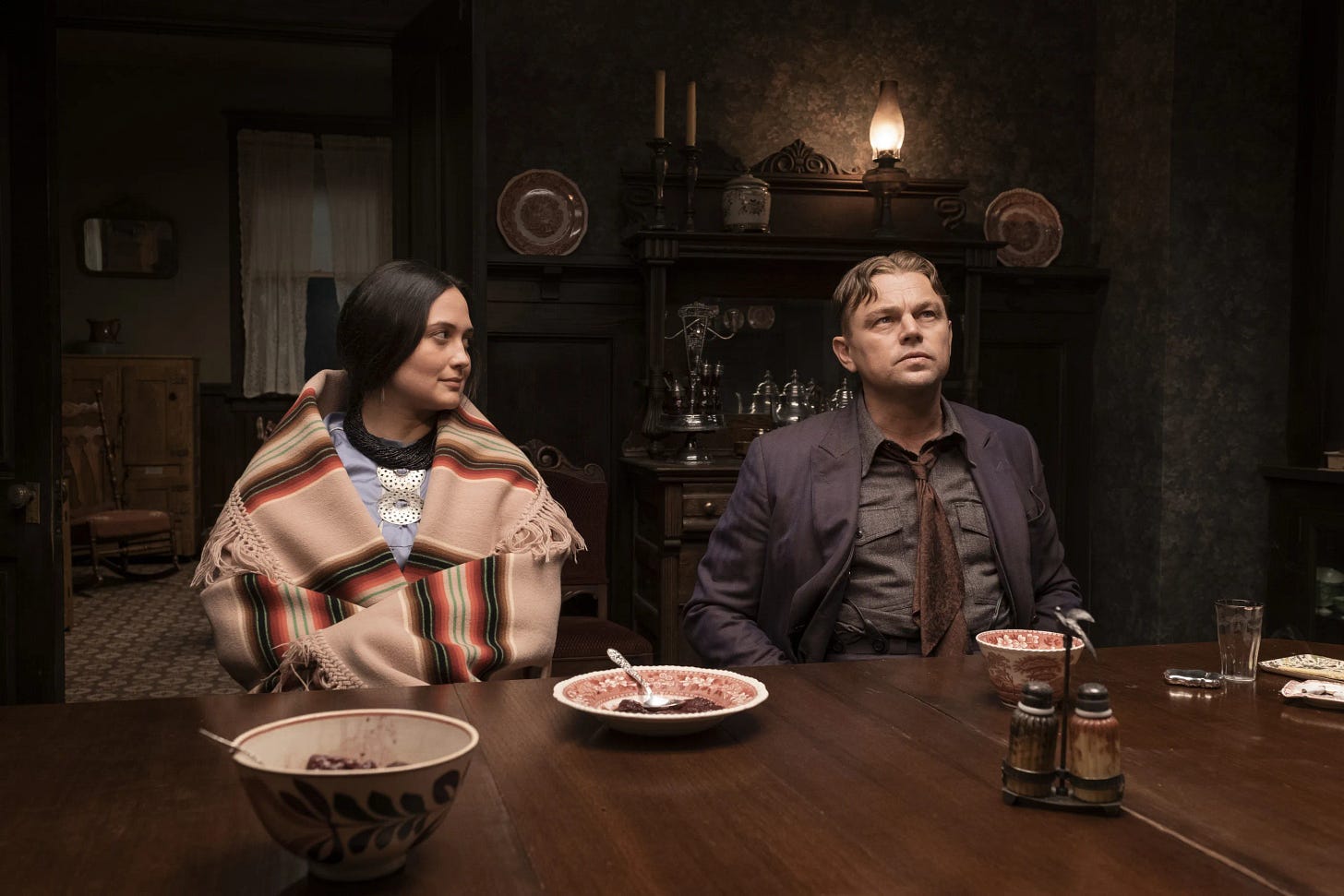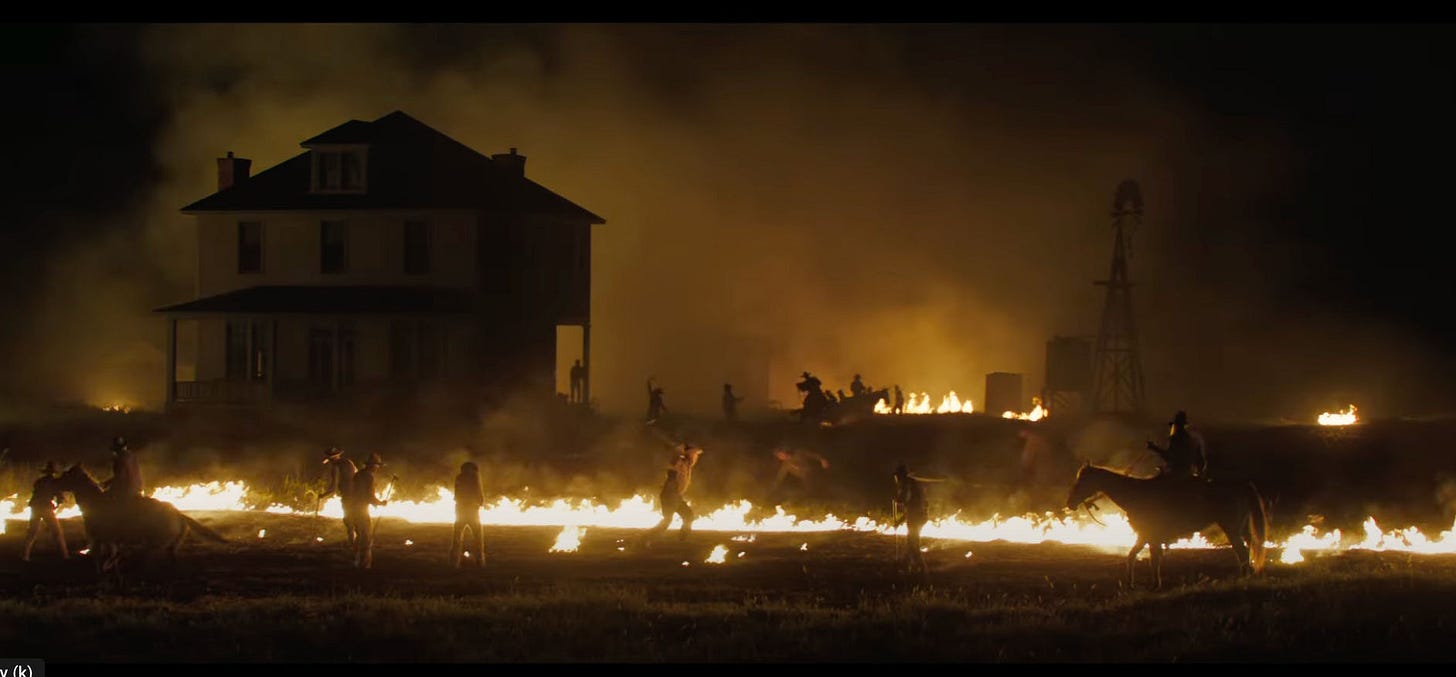Scorsese's ponderous Killers of the Flower Moon packs a surprisingly powerful punch.
While not one of Scorsese's best, Killers of the Flower Moon is worth watching to grasp the twisted ways white persons swindled the Osage, and for the Osage Nation's elegant, masterful response.
Killers of the Flower Moon retells an essential story of how the dispossessed Osage Nation accrued uncommon “good luck” in being relocated from their Missouri and Arkansas ancestral homelands to a resource-rich section of northeast Oklahoma Indian Territory known today as Osage County. At first, you’d think this historical epic is some Tarantino-esque revenge fantasy with Osage tribal members dressed as wealthy gentry with whites at their beck and call. But this upside-down world was no fantasy. This was life for the Osage in the early 1900s––per capita the wealthiest group of Americans at the time––as oil and gas revenue poured in and a menagerie of white tricksters worked to dispossess them of their entitled riches through sundry schemes, most profitably intermarriage and insidious laws that required whites to manage Osage money.
Operating freely on the Osage reservation is a crafty Osage-speaking snake, the sanctimonious, politically connected deputy sheriff and cattleman William “King” Hale (credibly played by Robert DeNiro). Through carefully feigned respect, humility, and compassion, this Iago of the Prairie gains the trust of Osage elders, enabling Hale to kill off wealthy tribal members and sub in his own kin to the resource rights and revenue. The tribal leaders are none the wiser since Hale has in his pocket local coroners, who disguise the real cause of death through false death certificates. Native Americans at that time were not allowed by law to have autopsies performed.
Enter King’s nephew, the malleable Ernest Burkhart (Leonardo DiCaprio), who along with his brother Bryon rob, murder, fleece, and otherwise undermine the Osage people in service to King’s sick replacement scheme. King is particularly interested in having Ernest wed Mollie Kyle (Oscar shoe-in Lily Gladstone), an Osage with “head rights”––federally protected property deeds entitling each owner to a lucrative quarterly payment from the Osage Mineral Estate.
In a different director’s hands, King’s perverse design would be strung along as a dark occluded mystery. But Scorsese is upfront about King’s machinations, moving the viewer off the smooth conventional murder mystery trail into a deeper offshoot: the Native American as watcher, seer, and knower, but not, ultimately, victim.
The film travels slowly through Mollie’s soft panoptic gaze (Osage is a French word for “calm water”). She falls for the scofflaw Ernest, the blue-eyed WWI veteran she calls her “coyote,” whom, despite his obvious predilection towards gambling, drink, and pool hall shenanigans, she oddly trusts until it is, at last, revealed to her what we know all along––her husband is trying to kill her with poison disguised as insulin. For a story so unfathomably dark, Scorsese tries to lighten things up with depictions of the clumsy antics of Ernest’s cussedly peculiar mountebank henchmen. But such comedic digressions never move us off the sordid and systemic evil at the heart of the story.
The only question Scorsese leaves hanging is: why did The Osage allow it? Their tall, strong, and healthy women were clearly not dying of what the white scoundrels called “wasting disease” or “diabetes.” Given all the horrors that had already been wreaked upon Native Americans through decades of white oppression, why did they not suspect? And why did the “uncommonly fierce, courageous, and warlike” Osage warriors not seek violent revenge upon their transparent tormentors once they knew?
It’s the same question that director Quentin Tarantino has the faux-French slaver Calvin J. Candie (Leonardo DiCaprio) ask in Django Unchained, as the namesake of the Candyland plantation performs a phrenological riff on the skull of an “old Joe” named Ben. But in that exploitation classic, Django Freeman (Jamie Foxx) exacts preposterously violent revenge on the entire edifice of slavery, including upon Candie’s right-hand man Stephen (Sam Jackson), an example of Malcolm X’s “house negro,” whose deal with the devil protected his own skin, until it didn’t.
In Flower Moon, there is none of the cartoonish eruptive expiation of Django. Instead, there is a slow burn of righteous despair as we witness one outrageous indignity after another inflicted upon the Osage People, who resort not to violence but to the white man’s legal, political, and law enforcement systems in order to at least partially right the murderous injustice. After all, it was the tribe’s sagacious decision to purchase their reservation land during the Native American allotment process that allowed them legal and financial protections no other Native American tribe enjoyed.
Their wise and effective redress reminds one of a similar drama that played out with the Ponca People, whose Chief Standing Bear also awakened the conscience of white persons with his courageous stand for human dignity in an Omaha courtroom. This fascinating connection between the white man and Native peoples around first principles endures to this day right here in Nebraska.
At one point, however, it had an odd dimension, which Flower Moon makes clear. Shallow viewers will think the sight of hooded Klansmen parading down the streets of Fairfax Oklahoma is some imposition. But that is not the case. The five main tribes of the 1860s fought on behalf of the Confederacy in the Civil War. My enemy’s enemy is my friend? Victims of injustice are almost never fully pure themselves.
DiCaprio is a slow-witted kind of powerful here. He is simple and clearly earnest, but still evil. He loves his wife but he is also dumbly beholden to forces far greater than himself. The beguiling King Hale is merely the conduit for those forces, which the film is not shy about revealing: Masons, bankers, and oilmen. Hale brags about all the good deeds he has done for the Osage Nation (schools, health care, roads, and more). But he is no different than any mafia don who gloats about bringing peace to the neighborhood or an occupying nation that proclaims that it taught the occupied how to read.
This theme of evil has obsessed the Catholic Scorsese his entire career. What is it? How does it operate? Why can’t we see it? Why don’t we quickly stamp it out once we do? Why do we excuse it, compromise with it, even celebrate it? And why, by God, are we so entertained by it?
As of this writing, about a quarter of the 2,229 Osage Nation head rights are owned by non-Osage people. To restore full justice to the Osage Nation, those rights should be voluntarily returned to the Osage people. That work continues one hundred years after what the Osage call “the reign of terror” was thrust upon them.
Many Native American viewers might be disappointed that Killers of the Flower Moon is another white-written, white-directed version of their story, but they will not be disappointed in the effect the film has on many white viewers, as at long last the grave injustice done to the Osage Nation, to Native Americans writ large, is put glaringly on the big screen by a director of stature and clout.






